Archive for ‘Task Management’ Category
Paper Doll On Understanding and Conquering Procrastination
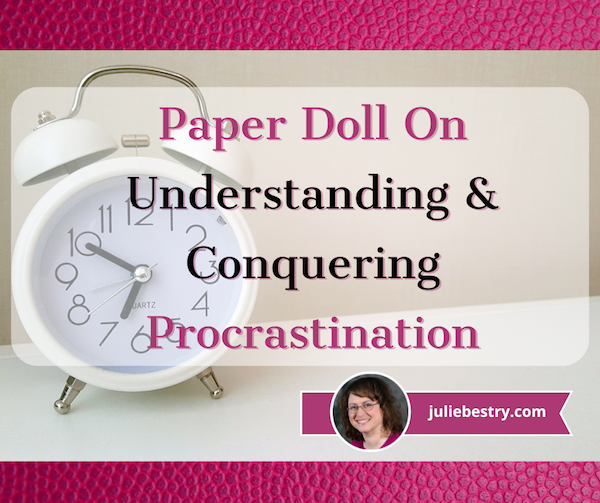
Nothing is so fatiguing as the eternal hanging on of an uncompleted task. ~ William James
We all procrastinate. Everyone knows that it’s irrational to put off doing something until the quality of the work might suffer. It’s obvious that it doesn’t make sense to keep not doing something when the deadline is fast approaching. And yet, at least sometimes, everyone procrastinates.
WHAT IS PROCRASTINATION?
Contrary to what you might have been told in your childhood (or even more recently), procrastination is not about laziness. Rather, it’s a self-protective mechanism.
Research shows that we use procrastination as a technique to regulate our moods. More specifically, to regulate, manage, and prioritize a negative emotion in the present over the negative outcome of our procrastination in the future.
Instead of delving into the science and scaring you off with words like amygdala and prefrontal cortex, here’s a cartoon to ease you into what’s actually happening in your brain when you procrastinate.
WHAT TRIGGERS PROCRASTINATION?
The tippy-top expert on procrastination, Canadian professor of psychology Timothy Pychyl of Carleton University in Ottawa, is the author of Solving the Procrastination Puzzle.
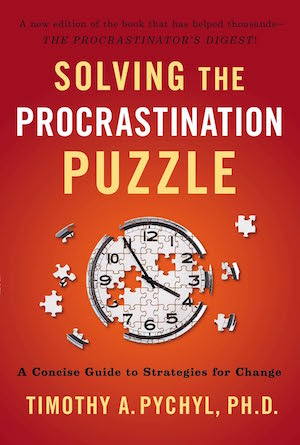
According to Pychyl, there are seven triggers that cause people to procrastinate:
- Boredom — Whether a child is delaying doing homework because the assignment isn’t challenging or an adult is facing a stultifying task (vacuuming, I’m looking at you!), doing anything stimulating (even if it’s counterproductive) may feel better than doing the boring thing.
- Frustration — The task itself may be frustrating because it’s full of difficult, fiddly little steps, like putting together a spreadsheet from multiple sources of data or figuring out how to build an Ikea desk without any written instructions; or, you might be frustrated because the work involves dealing with annoying members of your team.
- Difficulty — When something seems like it’s going to be too mentally or physically taxing, it’s comforting to procrastinate. Sometimes we tell ourselves that we’re preparing, or doing pre-work, to set the stage for the difficult task, but there are only so many pencils your teen can sharpen before settling in on that calculus homework.
- Lack of Motivation — This may seem the same as boredom, but it’s actually more complex. Boredom is mostly about the task; some activities are just inherently lacking in stimulation. But motivation relates to internal drive. Even if you aren’t happy in your current role at work, you may not be that excited about applying for a new job (perhaps because of depression, anxiety, or fear of change). You have to see the benefit of working on your resume and prepping for an interview as steps toward a personal goal of being more professionally confident, rather than just items to be completed to “get a job,” which may not be inherently motivating.
- Lack of Focus — Mental focus depends on physical and emotional stimuli as well as external stimuli. A variety of emotional concerns related to the task at hand — fear of failure, being embarrassed in public, losing a scholarship or a job — as well as unrelated issues like family or relationship troubles, or health concerns, can detract from your focus. Similarly, working in a crowded or noisy space, or even in an environment with visually distracting elements, can dilute your focus. Some people need to turn down the radio while driving to find the address they’re seeking; others need a tidy desk in order to read, even if the desk is outside their line of sight. You can’t focus if you’re hungry or tired, either.
- Feeling Overwhelmed — Too much of too much will always keep you from taking clear action. In the professional organizing field, we talk about suffering from decision fatigue and often say, “The overwhelmed mind says ‘No’.” Have you ever stood in the toothpaste or shampoo aisle and been shocked by the ridiculous number of competing alternatives? Similarly, if there are many different ways to approach a talk (writing a blog, replying to an email, making a plan for a move), overwhelm may lead us to just physically or mentally wander away.
so much to do pic.twitter.com/fiSm7Y2Erg
— poorly drawn lines (@PDLComics) December 21, 2022
- Being Overworked — Burnout is definitely a trigger for procrastination. If you’ve ever worked day-in and day-out on a project such that by the time you got home, you had literally no mental space or physical energy to do anything, even to prepare food, that’s a sure sign of overwork. Alternative options might be more or less pleasant (think: socializing or housework), but you might choose to lay on your couch and mindlessly scroll through social media instead of either thing you were supposed to do. Overwork eliminates the energy necessary for doing anything in the now, so everything gets pushed to a theoretical later.
Of course, Pychyl is not the only one to define triggers for procrastination. Others have identified fear of failure, impulsiveness (sometimes associated with ADHD), and generalized anxiety. Various executive function disorders can make it difficult to sequence or prioritize tasks.
The point is, procrastination is not laziness, but a conscious or even subconscious need to not feel icky now, even if you’re going to feel doubly icky later.
Procrastination is not laziness, but a conscious or even subconscious need to not feel icky now, even if you're going to feel doubly icky later. Share on XPRACTICAL STRATEGIES TO COMBAT PROCRASTINATION
Obviously, once you identify your trigger to procrastinate, you can employ techniques to reverse the behavior. For example, if a task is boring, like housework or working out, you might pair it with music or a streaming TV show.
It also may be helpful to take away the temptations of more entertaining options. Lock your phone in a drawer — having to unlock it to play Candy Crush may give you the necessary pause to stick with your task. If you’re tempted by websites that are more entertaining than the work you’re supposed to be doing, lock yourself out of those websites (for whatever time period you set) by using a website-blocking program like:
Cold Turkey — works with Windows and MacOS
Focus — works with MacOS-only
Forest — designed for your phone, it works with Android, iOS, and in your Chrome browser
Freedom — works with Windows, macOS, iOS, Android, in as a plugin for Chrome
LeechBlock — works in various browsers, including Chrome, Firefox, Edge, and Opera (but not Safari)
Rescue Time — works with Windows, macOS, Android, iPhone, and iPad
Self-Control — works with acOS-only
There’s also Paw Block, which, while it only works as a Chrome or Firefox extension, has the benefit of showing you pictures of kittens from the around the internet when it prevents you from accessing distracting websites.
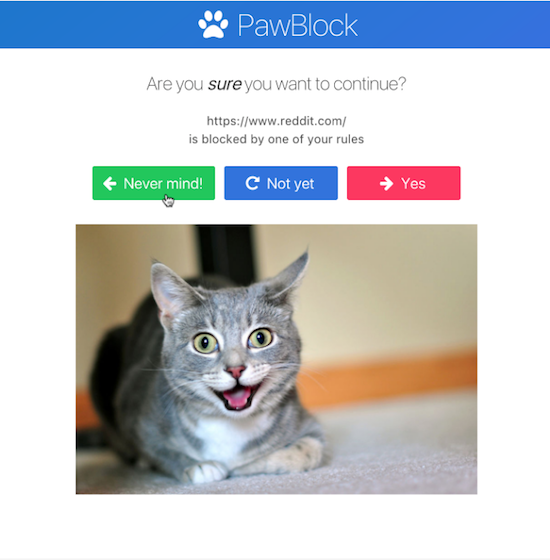
If you’re frustrated by the elements or situation of the task, you might bring in a friend or colleague to help you do it, someone who doesn’t have the emotional connection to the stressors that are throwing you off. They don’t necessarily need to perform the tasks, but just body double with you so you feel soothed and less frustrated.
You can break down difficult tasks into the tiniest possible elements, or seek a supervisor’s guidance, so the annoyances seem less annoying. (It’s tricky in the moment, but you might also try to reframe “difficult” tasks as challenges and contests with yourself.)
If you’re feeling unmotivated, see if you can find a short-term reward. (Cake? Cake is always good! But a refreshing walk outside after finishing the first of three elements of a task may help you get your head back in the game.) For a deeper lack of motivation, work with a therapist or coach to help you identify the meaningful benefits you can get from doing the things at which you tend to procrastinate, or possibly find a life path that eliminates those tasks. (If creating PowerPoint slide decks gives you a stomachache, maybe you need to consider becoming a lumberjack or a lighthouse keeper. Not everyone wants to be an knowledge worker, and that’s OK!)
If your procrastination is due to floundering focus, determine what’s contributing to the lack of focus. If it’s internal (troublesome thoughts and emotions), consider meditation, walking in nature, and talking through the excess thoughts with a friend and/or in therapy.
But if it’s external, if you’re feeling attacked from all sides by an overload of sensory stimuli, you may need to declutter and organize your space or move your workspace elsewhere (or invest in noise-canceling headphones). But it’s possible you’ll want to see if an ADHD or other diagnosis might help support your efforts to get assistance dealing with distractions.
Overwhelm may seem a lot like frustration. While you may be frustrated by just one (big) annoying thing, overwhelm feels like you’re getting pelted with dodge balls from all directions. It’s a good time to sit down with someone who can help you see the Big Picture and identify the priorities and sequences. Professional organizers and productivity specialists excel at helping you battle overwhelm and get clarity.
And if you’re overworked and experiencing burnout, it’s time to have a realistic discussion with your partner, therapist, boss, and anyone else who can help you achieve balance before you suffer health consequences more serious than just the emotional distress related to procrastination.
In the short term, some meditation and schedule modifications might work, but if you’re experiencing chronic overwork, more intense career and life changes might be necessary. Start by revisiting my series on toxic productivity, below, and pay special attention to post #3.
Toxic Productivity In the Workplace and What Comes Next
Toxic Productivity Part 2: How to Change Your Mindset
Toxic Productivity Part 3: Get Off the To-Do List Hamster Wheel
Toxic Productivity, Part 4: Find the Flip Side of Productivity Hacks
Toxic Productivity Part 5: Technology and a Hungry Ghost
You’re more than your job pic.twitter.com/qAHwtnT6Ux
— Junhan Chin | Illustrator (@junhanchin) August 31, 2022
EMOTIONAL AND INTELLECTUAL STRATEGIES TO COMBAT PROCRASTINATION
Making changes in your space and schedule, breaking your projects into smaller tasks, and giving yourself rewards are all smart practical solutions, but they’re external. Changing your external world can only eliminate some of the obstacles to your productivity. To truly conquer procrastination, experts advise making internal changes as well.
Admit it!
Denial is not just a river in Egypt. When you catch yourself procrastinating, acknowledge it. Once you call your own attention to the fact that you’re delaying doing the thing you’re supposed to be doing, you can look at that list of triggers and say, “Yikes! I’m avoiding writing this report. Why is that?” You can’t solve a problem if you don’t realize it exists. Admitting it gets you halfway to a solution.
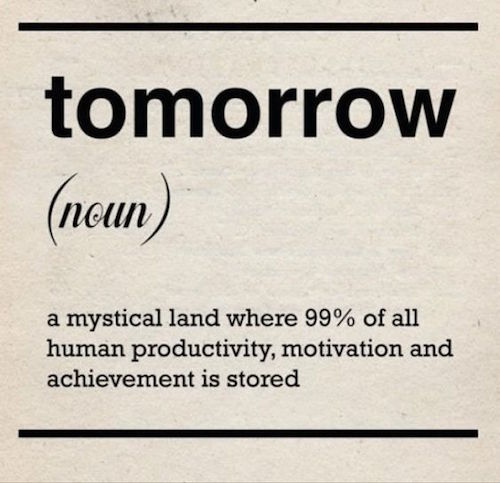
Forgive yourself
This isn’t the same as letting yourself continue to procrastinate. And just like forgiving someone else isn’t the same as saying that the undesirable behavior never occurred, forgiving yourself gives you the opportunity to recognize that past behavior doesn’t have to dictate future performance.
A 2010 study by Michael J.A. Wohl, Timothy A. Pychyl, and Shannon H. Bennett entitled I Forgive Myself, Now I Can Study: How Self-Forgiveness for Procrastinating Can Reduce Future Procrastination found, as the title indicates, that students who forgave themselves for procrastinating on preparing for exams earlier in the semester were far less likely to procrastinate on studying for the next exams.
You’re human; if you were a perfect person … well, you’d be the first one ever. Forgive yourself for having procrastinated in the past.
Practice self-compassion
Related to self-foriveness is self-compassion. Researchers found that people who procrastinate tend to have higher stress levels and lower levels of self-compassion, and theorized that compassion cushions some of the more negative, maladaptive responses that cause repeated procrastination.
Think of it as similar to overeating. If you cheat on your diet, low self-compassion might get you so down on yourself that you figure, “I’ll never lose this weight. I might as well just eat the whole ice cream carton!” But if you’re able to have self-compassion, you may tell yourself, “Yup, I did eat more than a half-cup serving of ice cream. But I understand why I did it. Next time, I’ll try drinking a glass of water and walking around the block first. Or maybe I’ll go out and eat the ice cream on the front porch, where the rest of the carton won’t be so accessible!”
(Seriously, whoever thought half a cup of ice cream was an adequate serving, anyway?)
Be intentional
All of the alternatives I described up above for seeking assistance and changing your environment (and the ones we’ll discuss next week) will only happen if you place your intention and attention on making changes.
Yes, this means a little extra labor on your part. If you know you procrastinate because you anticipate interruptions (from co-workers in the office or tiny humans when remote-working), you’re creating a problem before the problem exists, so you’re missing out on productivity before you need to and then again when the problem actually occurs. (And then you’ll spend the time after the interruptions being resentful about them, and that will lead to less productivity, too!)
Once you know what you’re up against and which triggers present a problem for you, build time into your schedule to plan your way around the obstacles and triggers. That might mean seeking out time with professionals who can help you, whether those are therapists, professional organizers, productivity specialists, or life or career coaches.
Embrace consistency
The various popular books on forming habits, like James Clear’s Atomic Habits, all agree that it starts with changing your identity, and seeing yourself as “the kind of person who” does things in a more agreeable, positive way.
Showing up daily is easier than showing up once in a while. pic.twitter.com/5CrOdIQjCu
— Sarah Arnold-Hall (@saraharnoldhall) February 6, 2023
One of the ways you can prod the formation of that kind of identity is to develop consistent actions and behaviors. In order to be the kind of person who goes to bed on time (and thus, can get up on time), you need to jettison the behavior of doom-scrolling for hours before bed. To consistently do that, you might set an alert on your phone for 8 p.m. to put the phone away, somewhere far from the couch or your bed. (Afraid you won’t get up on time if the phone isn’t near your sleeping area? Revisit my post from last summer, Do (Not) Be Alarmed: Paper Doll’s Wake-Up Advice for Productivity.)
Be a Self-Starter
You’ve heard me talk about activation energy before. In my post, Rhymes With Brain: Languishing, Flow, and Building a Better Routine, I wrote:
We also depend on activation energy. Because the hardest part of what we do is the getting started, we have to incentivize ourselves to get going. There are all sorts of ways we can trick ourselves (a little bit) with rewards, like pretty desk accessories or a coffee break, but the problem is that action precedes motivation. We’re not usually psyched to get going until we have already started!
Action precedes motivation. We're not usually psyched to get going until we have already started, whether it's a runner's high or Csikszentmihalyi's flow. Share on XA huge key to breaking the procrastination habit is getting started. After all, Sir Isaac Newton’s First Law of Motion states that a body at rest tends to stay at rest and a body at motion tends to stay in motion. (OK, it actually says, “a body at rest will remain at rest unless an outside force acts on it, and a body in motion at a constant velocity will remain in motion in a straight line unless acted upon by an outside force.” But this isn’t Physics 101.)
Did you watch the cartoon at the start of this post? (It’s OK if you skipped it; just scroll up and watch now and we’ll wait.) If you did watch, you know that you’re more likely to feel negative emotions about a task when you’re avoiding it, but when you’re actually doing the task, it doesn’t feel so bad.
So, get yourself in motion so that you can stay in motion! Get yourself past the hurdle of starting and that small victory of starting, and the realization that it wasn’t as bad as you feared, might make you less likely to procrastinate the next time you’re facing that same challenge.
GET STARTED AT GETTING STARTED
Once you’ve read all of the preceding advice, you still have to get your butt in the chair. (OK, yes, you could use a standing desk. Let’s not be pedantic!) There are two key ways to do that.
First, embrace accountability. As I’ve previously described in these various posts, borrowing willpower from others by getting support from “partners in crime” can be just the motivation you need to get started and stick with it, whatever the “it” is:
Paper Doll Sees Double: Body Doubling for Productivity
Paper Doll Shares 8 Virtual Co-Working Sites to Amp Up Your Productivity
Count on Accountability: 5 Productivity Support Solutions
Flow and Faux (Accountability): Productivity, Focus, and Alex Trebek
Second, even when you’ve got accountability support (and especially when you don’t), there are techniques for helping you get started on tasks in ways that feel hopeful, and that make finishing seem possible.
So, come back for next week’s post, Frogs, Tomatoes, and Bees: Time Techniques to Get Things Done, where we’re going to be doing a deep dive into a variety of well-known and sleeper strategies for eliminating procrastination. We’ll be talking about tomatoes and frogs, blocks and tocks, and so many numbers that you’ll think we’re in math class. (But I promise, just in case you tended to procrastinate on math homework, there will be no trains leaving Chicago at 120 miles per hour.)
Until next time, read more about the nature and causes of procrastination:
Why You Procrastinate (It Has Nothing To Do With Self-Control) ~ The New York Times
Why People Procrastinate: The Psychology and Causes of Procrastination ~ Why People Procrastinate
6 Common Causes of Procrastination ~ Psychology Today
7 Triggers of Procrastination ~ ChrisBaily.com
Procrastination triggers: eight reasons why you procrastinate ~ Ness Labs
When you tend to procrastinate, what triggers tend to haunt you? What methods do you use to keep procrastination at bay?
Surprising Productivity Advice & the 2023 Task Management & Time Blocking Summit
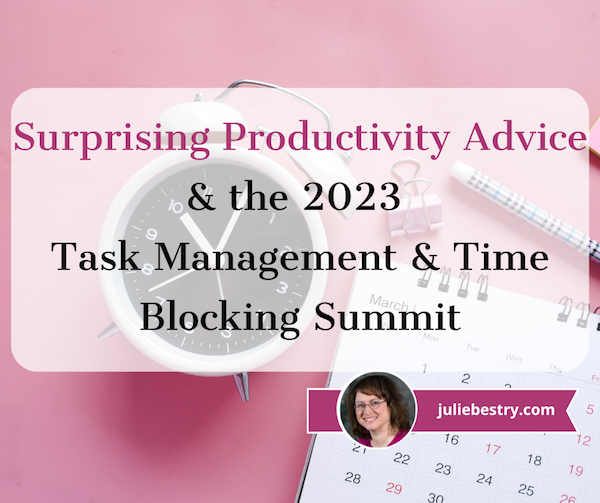
In fields like science, medicine, and technology, surprising information comes out all the time, and with that, novel guidance and advice. In the world of organizing and productivity, however, there aren’t a lot of unexpected, planet-sized discoveries or wrecking balls to old beliefs.
Rather, in most aspects of organizing and productivity, we seek to find novel examples and tweaks to help people understand the best approaches for what they already know deep down. Today, I’d like to share three intriguing ideas I’ve heard recently, and an opportunity for you to discover more.
WORK AS HOBBY: OVERCOME PROCRASTINATION WITH A MINDSET SHIFT
The first concept comes from my friend and colleague Hazel Thornton. You may recall her from Paper Doll Interviews the Genealogy Organizers and when I profiled her new book, Go With the Flow! The Clutter Flow Chart Workbook, in Paper Doll Presents 4 Stellar Organizing & Productivity Resources a few weeks ago.
Paper Doll’s Guide to Picking the Right Paper Planner

With two weeks until the new year, you’ve probably already started planning for 2023. But if you’re agitated about next year not being any more orderly than this one, you might be hesitating about committing to a planning system. Today’s post is designed to put you more at ease, and give you some guiding principles.
WHY USE A PAPER PLANNER?
There’s nothing wrong with using a digital calendar. I use one myself, though not for scheduling. I use my digital calendar so that when I get an email with Zoom logins, or have a telephone consultation with a prospective client, I don’t have to go looking for the emails to find the links or phone numbers.
In Outlook, I can create an appointment or task directly from an email, and the system will prompt me at a pre-set time with all the key details. It’s like having my own personal Jeeves pop his head into the room to let me know the countess and duchess have arrived to join me for tea.
But honestly, I never use my digital calendar to plan my life. I’m a Paper Doll, so it stands to reason, I prefer a paper planner. But how do you know what’s best for you?
Let’s start with the mindset, and the different advantages and disadvantages of paper planners vs. digital calendars.
Learning Curve
If you are over the age of eight, you already know how to use a paper planner. On the monthly view, there are boxes for the days of the month to put major events, deadlines, and vacations. On the weekly and/or daily views, you can time block for tasks and list appointments.
Digital calendars aren’t complicated, per se, but they are not always intuitive. There might be a generational schism at play, but I’ve had clients try once, twice, even three times to input an appointment, only to have some technical or user kerfuffle lead them astray.
Why does this matter? Digital fatigue creates friction, and friction prevents people from completing a task, whether it’s removing the lid to the laundry hamper to toss clothes in, or schedule an appointment when the system isn’t working.

Woman With Planner Photo by Marten Bjork on Unsplash
Digital fatigue creates friction, and friction prevents people from completing a task, whether it's removing the lid to the laundry hamper to toss clothes in, or schedule an appointment when the system isn't working. Share on XControl vs. Convenience
At first, the ease of clicking to accept a meeting invitation would seem like an advantage for digital calendars. But is it?
When I train clients to improve their productivity, we focus on identifying priorities so that we can protect boundaries around them. On a digital calendar in your phone, you generally see the month with blobby dots signifying appointments on particular days.
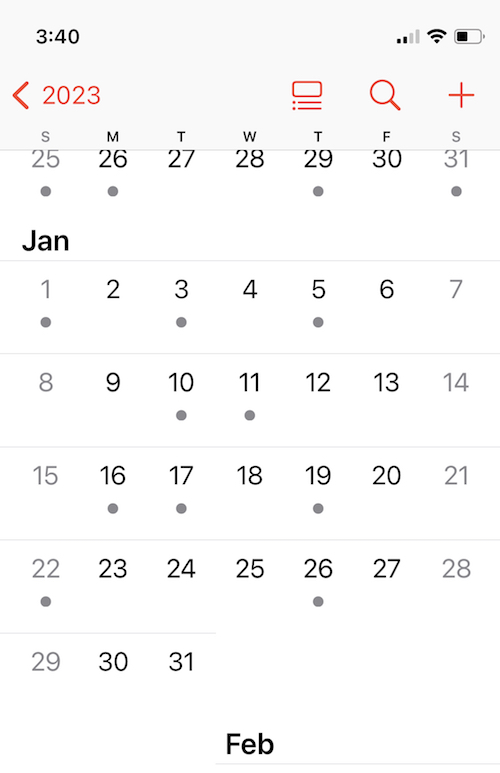
You have to click through to look at the individual date to schedule the meeting, but then you’re losing the surrounding context because you’re just seeing one appointed after another another in a list. Again, you can’t see time.
When we brainstorm ideas, schedule appointments, break projects into tasks and plan when we’ll do them, we’re thinking about context. When we see a whole month of appointments on the printed page, we instinctually know we have to give ourselves (and our brains) some recovery time. That’s less obvious when we only see the one time slot and the computer merely tells us if there’s a conflict. (Also, on the digital calendar, it’s less clear that you haven’t scheduled time for a potty break or commute.)
Many people — children, college students, people with ADHD, overwhelmed professionals —often suffer from a lack of ability to visualize the passage of time. An analog planner involves more tactile interaction with the appointments and tasks we schedule. As we deal with finding a reasonable time for each time, we gain mastery, not only over our schedules, but our comprehension of time.
Cost
Basic digital calendars are built-in to our phone and computer systems, and most apps are inexpensive. Conversely, paper planners may run you from $20-$50. But when it comes to our planning tools, cost does not necessarily equal value.
Yes, there’s a dollar value to the purchase price of an app vs. a paper planner. But there’s a time value related to mastering a new calendaring system. Are you prepared to commit yourself to learning the intricacies of a new app or the same app every time it updates?
Privacy vs. Searchability
This is another close call. Your paper planner is completely private, as long as you don’t leave it unattended; a digital planner generally syncs across all of your digital devices, which means that while it should be private, there’s never a 100% certainty that there are no prying, hacking eyes.
Conversely, your digital calendar is usually searchable. You can type a keyword or person’s name to find a scheduled appointment or task. Your planner can only be searched by trailing your gaze across each page, and the less careful you are with entering data, the more you risk losing the information when you need it.
Visual vs. Visual+Tactile
When you drive, do you think in terms of linear directions, or are you more inclined to recall what to do when you reach landmarks? If you prefer linearity, go digital; if you like touchpoints and landmarks, paper will likely resonate more.

Hand in Water Photo by Yoann Boyer on Unsplash
Does digital time “feel” real to you? On a digital calendar, every item appears in the same font and size. You can often color-code items, but digital entries have a vague sameness about them.
If you write something down, you can stop thinking of it, per se, and start thinking more robustly and contextually about it. Somehow, dragging an email into Outlook to set a meeting, or typing an appointment into your phone, leads to an out-of-sight, out-of-mind situation for many. But with a tangible paper planner, every time you eyeball your month or your week, you are speedily, comfortingly reminded of the important aspects your life.
Similarly, your fine motor skills applied to the task tend to be the same; you could be typing a grocery list or the key points for an interview (then buried into the notes section of a calendar event). With a paper planner, your tendency to print some things and handwrite others, your ability to use a particular color pen, to draw arrows and circles and adjust the size to shout or whisper on the page, yields a unique temporal language that makes sense to you.
Will a weighty paper planner “feel” more real to you vs. that free app (among dozens) on your phone?
Only you know for sure. For me, it’s a paper planner, all the way. But not all paper planners are created equal.
WHAT TO CONSIDER WHEN PICKING A PAPER PLANNER
Anxiety over making the wrong planner choice is common; it’s one of the reasons people give up one planner and buy another mid-year. You don’t want to plunk $30 or $45 on a pile of paper that will sit like a lump on your desk because you’re afraid to “mess up” a pretty planner. This keeps people from committing to their planners and being successful at scheduling events and tasks.
Some users want simplicity; others desire flexibility. Some clients want aesthetically pleasing planners to inspire them, while others seek a serious, “professional” look. There’s no one perfect planner for everyone, but there are clues in how you feel about potential features.
Page Design
- Adequate space — to show appointments and key information, especially on the monthly view. If you’ve got loopy handwriting, will small monthly view boxes cramp your style?
- Layout for monthly/weekly/daily views — Understand how you “see” time. Also, depending on your life and lifestyle, consider whether you need an academic or full-year calendar, or a planner with lots of extra space for weekend and night activities.
- Creative fields — Modern planners may give you spaces for more than just appointments and tasks. Do you want bubbles or fields or pages for note-taking, brainstorming, mind-mapping, or gratitude journaling?
- Practical fields for tracking metrics — On the flip side of those creative attributes, there are planners with spaces for habit tracking, budgets, meals/nutritional logging, goal-setting, and other countable, observable elements.
- Bonus features — Are you drawn to daily motivational quotes, religious references, or cartoons? I never loved my Franklin Planner so much as the year I was able to get one with a New Yorker cartoon each day. I’ve enjoyed my colorfully-tabbed Emily Ley planner for the last few years, but miss daily quotes and bits of wisdom.
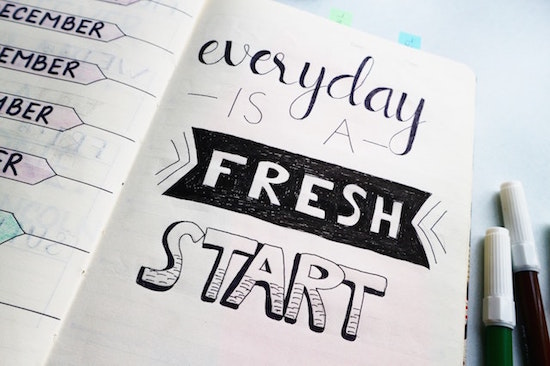
Planner Quote Photo by Bich Tran
Planner Design
In addition to features on the page, you might care about the design specifics of the planner itself:
- Size — Do you think you’d like an executive, classic, or condensed planner? The largest sized planner may not fit in your bag, or may take up too much real estate on your desk, but the tradeoff of picking the smallest option will be losing writing space.
- Weight — Does a hefty paper planner give you a greater sense of gravitas so that you’ll take your schedule seriously? Or will the bulk make it inconvenient for you to carry around?
- Binding — There are ring binders (usually with 7 rings), which let you choose how many pages you want to carry with you at any given time. (I like all the monthly pages, but prefer only last month, this month, and next month for weekly/daily pages.) Coil binding won’t let you remove or add pages, but tends to be more condensed. Both ring and coil binders assure your planner will stay open and lay flat; stitched binding may flop closed when the planner is new, and “perfect” binding (glued, like with a paperback book) can deteriorate with rough handling.
- Cover Style — Do your want your planner to have a leather (or “vegan leather”) cover for a fashion statement? What about a zipper? Are you good with a plastic or stiff paper cover? Will a simple planner cover help you take your planning more seriously or bore you? (Or are you willing to upgrade a staid cover with artwork or washi tape?)
Also remember that your planner is mostly about knowing what you have to do and when. If you need help with project management at the more granular level, take a peek at last year’s Checklists, Gantt Charts, and Kanban Boards – Organize Your Tasks.
PLANNER FORMATS: FOR WHOM ARE THEY REALLY DESIGNED?
As I research planners each year, I find that most planners fall into one of a few general categories:
Basic Planners
Think back to before the computer era, when you’d go to the dentist. Before leaving your appointment, the receptionist would consult a big, black-covered planner with neat columns, flip forward in the book, and write your name for a particular date (column) and time (row). That’s the what you’ll get when you seek various office supply store-branded calendars: columns and rows and not much else.
Basic planners offer a variety of the planner design elements above, but relatively few extra page design options. Popular examples:
At-A-Glance — is the most like that dental office planner in the days of yore. It’s efficient and practical. If you’re easily distracted by colorful design elements, this style should keep you on the straight and narrow.
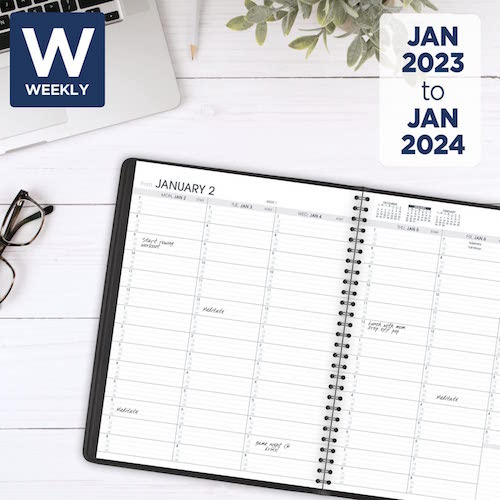
Franklin-Covey planners in the ring format are customizable. You not only get to pick your planner size, but also choose from a variety of themes. There are spaces for appointments, tasks, and notes on the same page; others have little boxes for tracking expenses. You can also purchase pages for contacts, more notes, budgeting, and a number of other extras.
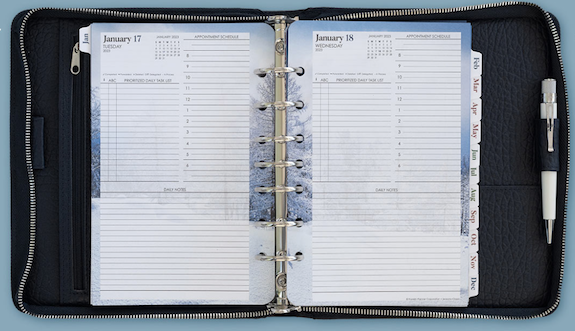
Levenger Circa SmartPlanners come in junior and letter sizes and some DIY customization. They use ring-like discs, such as we discussed in Noteworthy Notebooks (Part 4): Modular, Customizable, Disc-Based Notebooks.
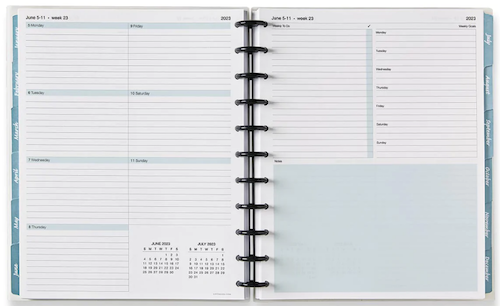
Moleskine planners comes in a wide variety of sizes, colors, bindings and styles for monthly, weekly, daily, and combination views. Much like Moleskine notebooks, these are well made, with curved corners and elastic closures. These are often suited to creative souls who still want to stick to a simpler style and format.
Planner Pads are the planners I recommend the most often to the widest variety of clients. There are monthly calendar pages, but the heart of the system is the weekly pages divided into three sections (projects/tasks, daily scheduled tasks, and daily appointments), which “funnel” the overall projects and tasks to where they belong each day. However, cover choice is limited to black and a sort of seafoam green. I’ve said it for years, but Planner Pads is missing a great marketing opportunity; they already have the best basic planners — why not make them a little more attractive?
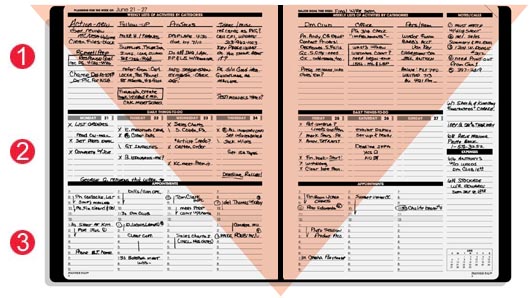
Passion Planners are still pretty straightforward, with columns for each date and sections for work and personal tasks and for notes, but they add weekly sidebars for focus areas and a place to jot down the “good things that happened” that week. The covers are faux leather and come in a variety of sumptuous colors; choose cover design, pick one of three sizes, and decide whether you want your week to start on Sunday or Monday.

Basic planners are the best for time blocking. (For more on this, see my Playing With Blocks: Success Strategies for Time Blocking Productivity from last year.) They tend to be promoted as gender-neutral options, with rare prompts for life goals or touchy-feely stuff.
“Fancy” Planners
For want of a better term, these are a step up from the basics. It’s worth noting that fancy planners marketed to women tend to focus on aesthetics and tracking emotional/psychological factors; planners marketed to men tend to include more tracking of quantifiable action-based metrics.
There are a handful of smaller sub-categories I’ve noticed in this realm.
The Animal Planners
Panda Planner — In addition to scheduling tasks and appointments, it covers inspiration and goals in sections labeled “Today’s Priorities,” “Morning Review,” and “Things I Will Do to Make This Week Great.”
Paper Doll on the Magic of Making Lists

THE APPEAL OF A LIST
Paper Doll is a sucker for lists.
My childhood diaries (y’know the kind, pink with a lock that could easily be opened by a bobby pin) were just page after page of my mini-me wishes and hopes.
One of the first organizing-related books I ever purchased (when I was still in high school, back when dinosaurs roamed the earth and the top song on the Billboard charts
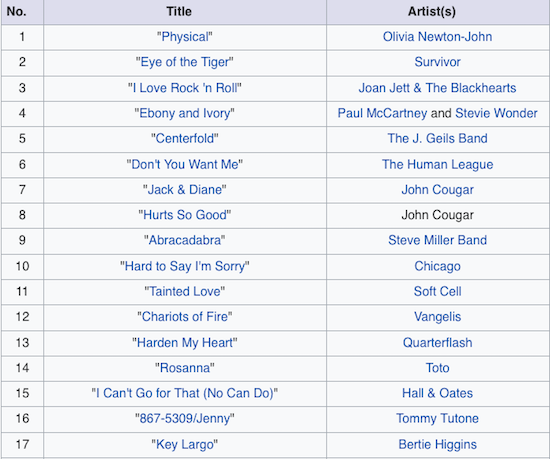
was Olivia Newton-John’s Physical), which still sits on my bookshelf, was Checklists: 88 Essential Lists to Help You Organize Your Life. It contains a wide variety of lists my 15-year-old self assumed would be, as the book title indicated, essential for becoming an adult.
Many of the lists were, and still are, useful. The “What To Do” checklists started with life transitions like how to find a roommate, plan a wedding, prepare for having a baby (or adopting one), buy a new or used car, or get ready for a move. These continued on through less happy events, like what to do if you’re going through a separation or a divorce, are a victim of a burglary, have to stay in the hospital, or need to plan funeral arrangements.
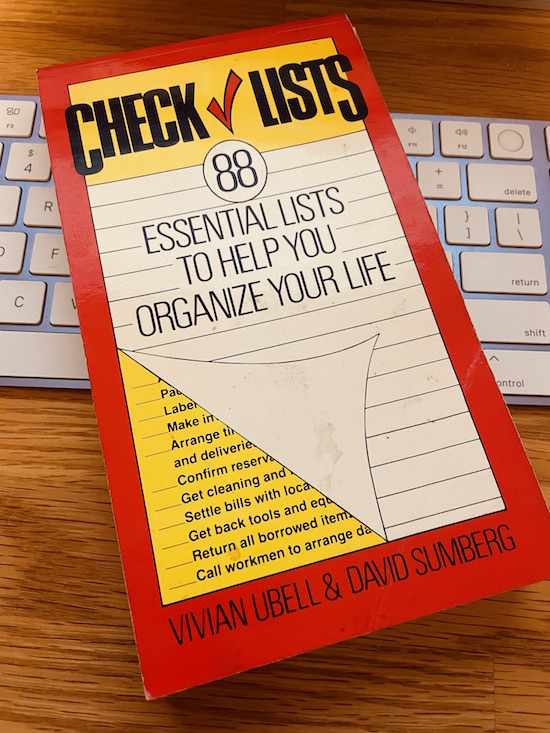
I will grant you that many of these step-by-step To Do lists, such as how to apply to college or for a mortgage are outdated these forty (gasp!) years later, and I can’t say I ever found the lists for buying a summer home or putting my boat in the water particularly useful. Oh, but the aspirational aspect of it all!
The other sections of the book were equally magical, with checklists for packing (for everything from a day at the beach to — I kid you not — sending your child to boarding school) to hosting social events (from children’s birthday parties to showers to Christmas dinners and Passover seders). And even after 20 years as a professional organizer, I still take a gander at the “What to Have” checklists for organizing every space from tool boxes and medicine chests to linen closets and garden sheds.
Even last week, when I was perusing the new books shelves at my public library, I couldn’t bring myself to bypass 52 Ways to Walk: The Surprising Science of Walking for Wellness and Joy, One Week at a Time.
Struggling To Get Things Done? Paper Doll’s Advice & The Task Management & Time Blocking Virtual Summit 2022
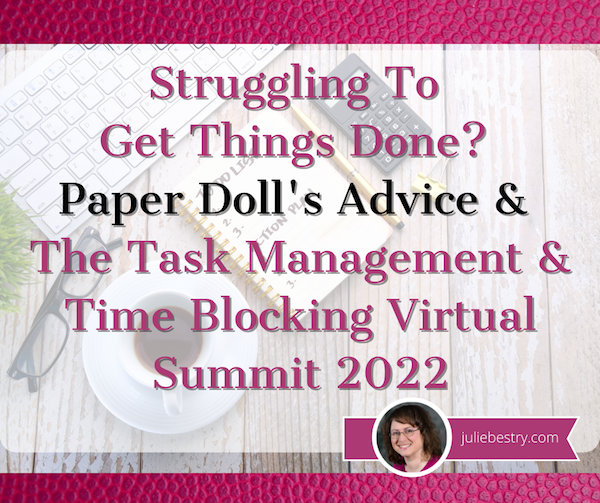
You have task lists. You have apps filled with task lists. You have alarms set to remind you to check your apps filled with task lists.
And yet, do you sometimes feel down in the dumps because you can’t achieve what you set out to do? If so, congratulations. That means you’re human. (No offense intended to my intergalactic readers, of course.)
The common parlance for solutions to getting things done is “time management,” but as you’ve heard me say often, we cannot manage our time, but only ourselves. Notwithstanding crying children, screaming bosses, and messed-up public transportation schedules, the inconvenient truth is that we really are the only ones in charge of what we do and when we do it.
Yes, there are consequences to us making the choices we do, but the key is that we’re controlling our reactions to the demands on our time. The minute we relinquish belief in our own control, we’re deciding the game is lost.
Thus, I see my role as one of explaining all of rules of the game, letting you know about the sneaky combatants trying to sabotage you (whether they’re in your own brain or out there in the world), and trying to arm you with mighty powers to vanquish whomever is trying to steal your time. (And yes, I realize this does seem to sound more like Dungeons & Dragons than time management.)
WHY WE CAN’T GET A HANDLE ON TASK and TIME MANAGEMENT?
There are a variety of reasons why people find it hard to accomplish important things.
Maybe We Don’t Know What’s Up
Sometimes, you’re unhappy with the way things are but you can’t really identify the problem and don’t know there’s a solution. (If that’s the case, Organize Away Frustration: Practice The Only Good Kind of “Intolerance” offers some guidance for both recognizing that there is a problem and locating a solution.)
Other times, you know what you need to accomplish and you do want to do it, or at least, you want to have done it. (In the words of Dorothy Parker, “I hate writing. I love having written.”)
Other times, you know what you need to accomplish and you do want to do it, or at least, you want to have done it. (In the words of Dorothy Parker, *I hate writing. I love having written.*) Share on XIn those cases, when your get-up-and-go has got-up-and-went, there can be a number of causes. Read on.
Maybe There’s a Pandemic Going On
Early in the pandemic, there were the shifting sands beneath our feet as we couldn’t quite get a handle on things, so I wrote Does Anybody Really Know What Time It Is? 5 Strategies to Cope With Pandemic Time Dilation.
In that post, I covered research that is still apt today, about how the pandemic caused us to lose our sense of routine. Even if you’re back to working in the office, you don’t know if your child’s school is going to be closed unexpectedly, if planned meetings will “go virtual,” or if something (anything!) will turn out as it was planned. Two years on, and we are absolutely not back to normal, whatever we used to think that meant.
We also examined the research showing that our brains turned mushy, largely due to lack of novelty (for the work-from-homers) and something related to allostatic load, where our bodies’ physiological reactions to emotional stress caused a build-up of stress hormones. So, we couldn’t get our bodies in gear with the energy needed to perform all of the regular life-and-work mental tasks.

Photo by Andrea Piacquadio from Pexels
And then our body clocks were out of whack because we weren’t sleeping (normally or otherwise), eating (normally or properly, and everyone’s move to drawstring waists seems to reflect that), we weren’t getting enough fresh air or sunlight, and we were getting too much blue light from our devices…which made it hard to sleep.
Guess what? We’re all still having trouble with these things, to one extent or another, two years on. We may have moved from the dining room to a bedroom turned into an office, or even back to our real offices. We’ve have moved on from Tiger King to Inventing Anna. But everyone is still having trouble with productivity!
In that post, I suggested strategies to cope with time dilation and get reconnected to time. If your task list means you barely have time to read this post, here’s a summary:
1) Put structure in your life.
Create daily rituals so you have a real sense of the start and end of your workday, and develop buffer habits so your brain gets the same benefits of a commute even if you’re walking around the block instead of driving to work while listening to your favorite podcast.
Time block to create boundaries in your day. (Of which, more later.) By blocking off specific times in your schedule for overarching categories (passive work projects, creative/active work projects, self-care, self-education, entertainment) you’re guaranteeing that there’s a place in your schedule for each. Knowing this gives you a sense of security, a system upon which you can depend.
2) Enhance novelty.
I offered up a laundry list of ways to boost novelty and get your brain making new synaptic connections. If every late winter slog through your day has been cold, grim, and not very novel, connecting with people you don’t normally speak with can spark enthusiasm for all sorts of things on your to-do list. It doesn’t matter whether that spark is a mild sense of competition with a former colleague or a stray comment you can build on to turn your work in a bold new direction.
In addition to new(ish) people, I suggested trying out different spaces, like working from a guest room or even moving furniture around to give you a new angle or a new vista.
3) Create vivid sensory clues for the passing of time!
At the time, I said:
Go Analog. Digital clocks don’t give you the same sense of the passage of time as old-school watches and clocks. Start by looking to see which of your digital clocks you can change to an analog appearance. Android phones allow you to change your lock screen from digital to analog easily. On the iPhone, the clock app iconis a working analog clock, but the lock screen stays digital. There are apps like FaceClock Analogue to give you a working clock, but they can’t be added to the lock screen.
I encouraged embracing the Time Timer and even hourglasses. The key? Shake up your relationship with time and make it more real.

4) Get what you know you need! I covered everything you needed to get enough of: daylight, sleep, exercise, and normalcy (including getting groomed and dressed). Judging from the people in PJs and slippers I see in the grocery store parking lot, I don’t think this can be said strongly enough.
5) Take a Technology Break – In some ways, this goes along with what I said about taking your view of time analog. Our dependence on technology takes us away from the reality of what we’re trying to do. Whenever possible, deal with the real and tangible.
Unplug when you can so you’re refreshed when you have to plug back into the matrix.
Oh, and in case you’re having trouble getting things done but feel like all of that stuff about the pandemic is old news, I invite you to read Rhymes With Brain: Languishing, Flow, and Building a Better Routine. The post dug deeply into brain-related changes you can make to get your mojo back in gear.
Maybe We’re Trying to Go It Alone
I mean, come on, any good D&D (or other tabletop game) player will tell you that you can’t go it alone. You need to forge partnerships. At the risk of pulling out every “maybe it was really the friends you met along the way” trope from TV and movies, getting support is essential.
There’s a reason they say, “If you want to go fast, go alone. If you want to go far, go together.”
To that end, if your obstacle to getting things accomplished is a lack of external motivation, then look no further than two now-classic Paper Doll posts:
Count on Accountability: 5 Productivity Support Solutions walks you through options for motivating yourself through accountability with friends and strangers, individuals and groups, random humans and paid professionals.
Flow and Faux (Accountability): Productivity, Focus, and Alex Trebek pushes your task management forward when you can’t (or don’t want to have) an actual person pushing you to get your lists checked off, but you do need some kind of push. This post offers up a deeper understanding of what doesn’t work about virtual support and what does, so you can benefit from a little artificial intelligence (or artificial environments) without finding yourself stranded in an uncanny valley.
Maybe Our Spaces (or Our Brains) are Too Loud
Jump five years into the past for this Paper Doll classic. 5 Keys to Focus, or What Lord Chesterfield Knew About Multitasking, is (shockingly) one of the shortest posts in my 15-year collection.
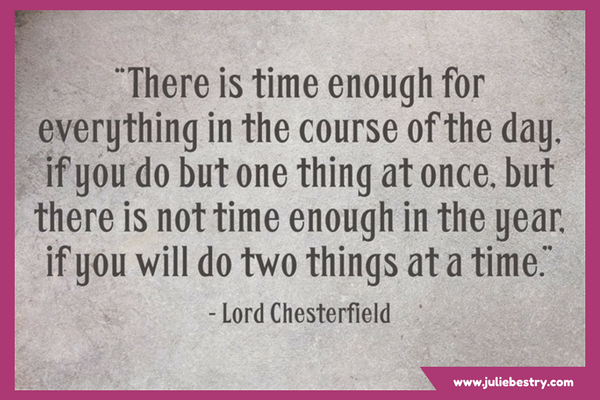
From decluttering your physical and digital workspaces to shushing the distractions out there (in the world) and in there (in your head), to actually scheduling time to get it all done (ahhhh, there’s that hint again), this post will help settle your mind and turn you away from the dangers of multitasking.
Maybe We’re Stuck in the Past
If you can’t seem to move forward and take action on your tasks, maybe something is pulling you back?
It’s not always about finding a different method of keeping your conveyor belt of task management moving. If you need something with a little more of a philosophical bent to get you to let go, try reading Emerson, Angelou, Ted Lasso, Tashlich & Zen Monks: Letting Go for a Fresh Start.
Maybe We Haven’t Found the Right Tool or Magic Solution Yet?
Ah, you know this one. The truth is, there are no magic wands. (I told you so in The Truth About Celebrity Organizers, Magic Wands, and the Reality of Professional Organizing.)
There are bad solutions, like the kinds you see advertised on social media. (If you only see ads for a solution to something in the organizing and time management world, but aren’t seeing any of your favorite expert bloggers talking about the solution, there’s probably a good reason for that.)
And there are good solutions applied badly (or at least inexpertly).
And there are stellar solutions that work if you commit to learning, tweaking, and making your own.
I’ve certainly advised readers on my share of time and task management options. In the blog post about time dilation, I talked about the Pomodoro Technique, which is great for taking baby steps toward starting (and completing) tasks and conquering procrastination.
Other times, the blog has delivered insight about cognitive or tangible tools for organizing or accomplishing tasks:
Checklists, Gantt Charts, and Kanban Boards – Organize Your Tasks
Project Management Tools To Get It Done in 2019
Playing With Blocks: Success Strategies for Time Blocking Productivity (and ooooh, that was a good one!)
And that last post is our long-awaited segue to what I especially want to share today — an opportunity for you to get some cutting-edge information from a gaggle of experts (myself included) on task management and time blocking.
THE TASK MANAGEMENT AND TIME BLOCKING VIRTUAL SUMMIT 2022
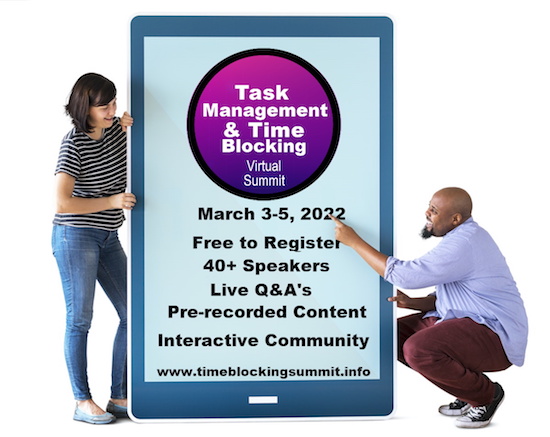
This all starts with my friend, colleague, fellow Cornell University alum — and, we were surprised to learn, former dorm-mate — Francis Wade, founder of 2Time Labs in Jamaica.
Francis operates in the field of “applied research in a world of increasing time demands.” (Sound familiar?) He’s also the author of Perfect Time-Based Productivity: How To Protect Your Mind As Time Demands Increase. (You can read more about the book here.)







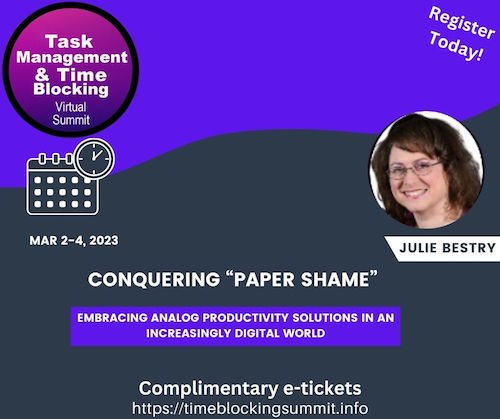
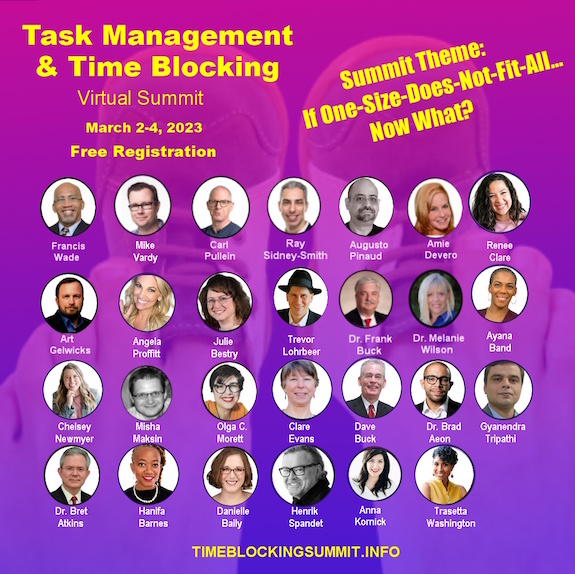
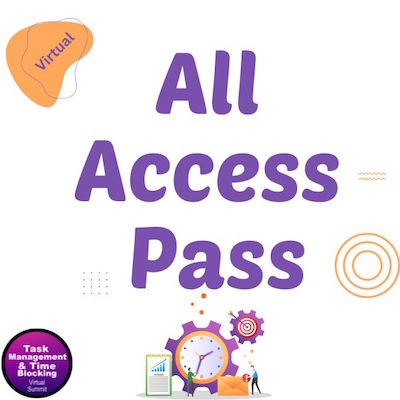 If you want more time to absorb everything, you can purchase an
If you want more time to absorb everything, you can purchase an 





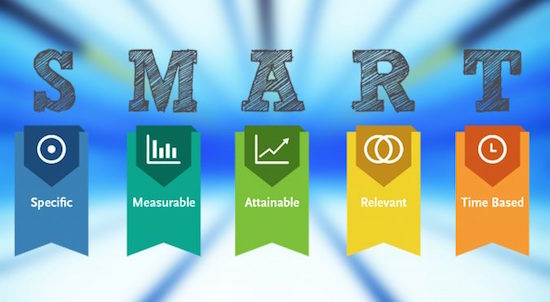






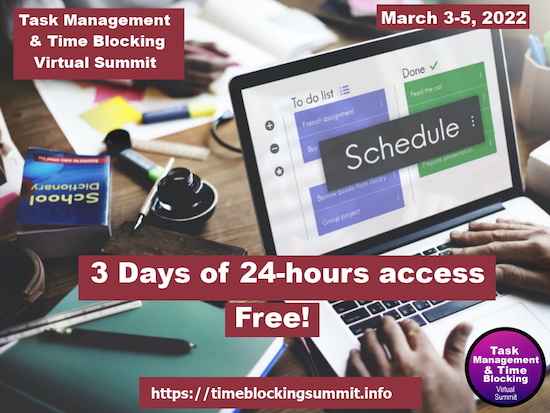
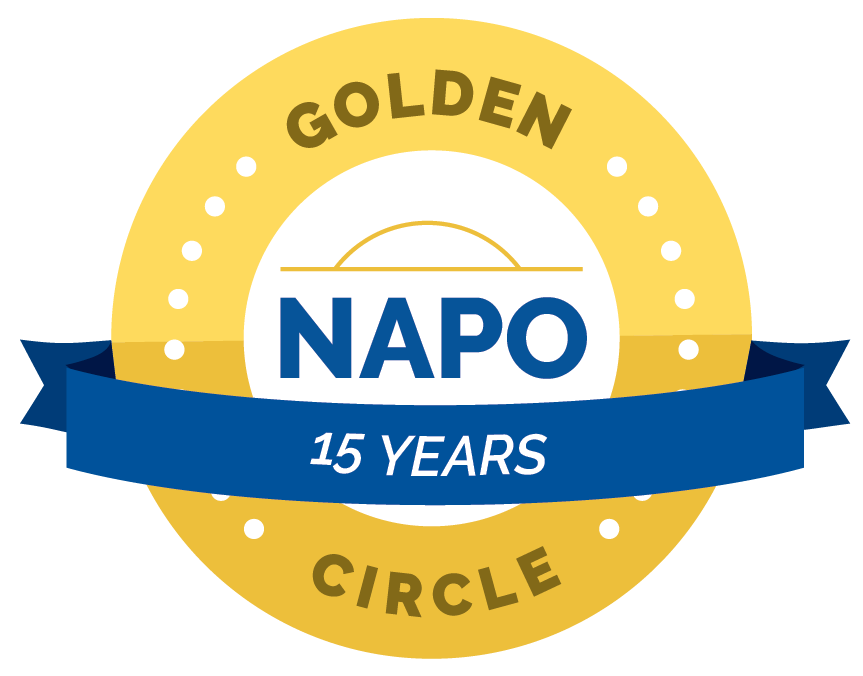
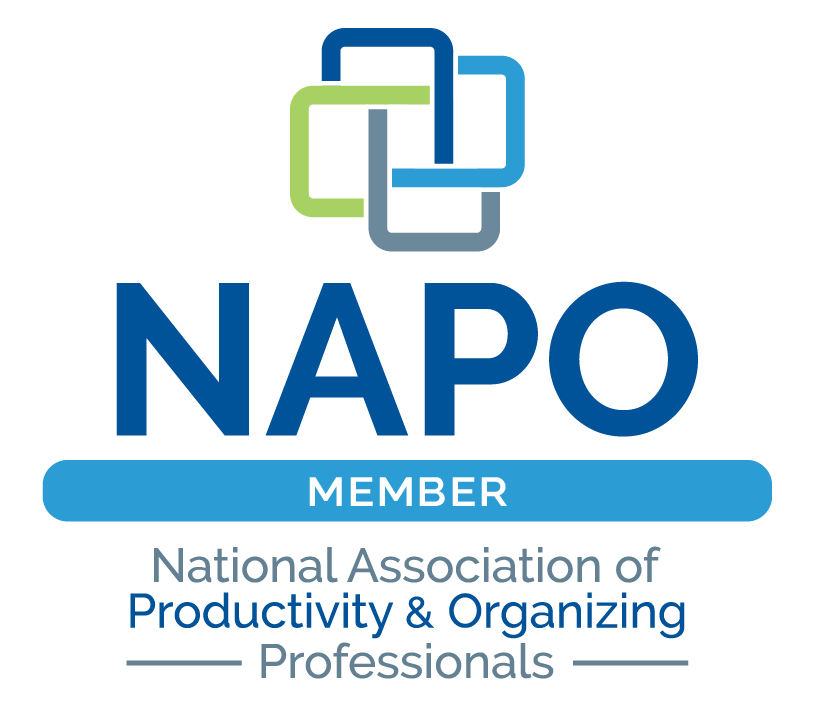

Follow Me